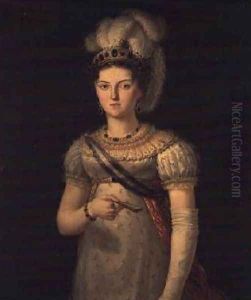Francisco Lacoma Paintings
Francisco Lacoma y Fontanet, born in 1778 in Spain, was a notable figure in the realm of Spanish painting, particularly celebrated for his portrait work and landscape paintings during the late 18th and early 19th centuries. His artistic journey reflects the stylistic transitions of the period, showcasing influences from Neoclassicism and the burgeoning Romantic movement. Lacoma's life and career were deeply intertwined with the cultural and political upheavals Spain experienced during his lifetime, including the Peninsular War and the subsequent shifts in Spanish society and monarchy.
Lacoma's early life and education in art remain somewhat obscure, but it is known that he was active in notable artistic circles in Spain, contributing to his development as a painter. His works, especially his portraits, were highly regarded for their depth of emotion and realism, capturing the essence of his subjects with a nuanced understanding of light and shadow, which was a departure from the more rigid and idealized forms of Neoclassicism. Lacoma's landscapes, on the other hand, often depicted serene and idyllic scenes that contrasted with the tumultuous era he lived in, potentially offering an escape or a longing for stability and peace.
Throughout his career, Francisco Lacoma exhibited his work in various prestigious venues, gaining recognition and accolades for his artistic contributions. His paintings today are considered important in the study of Spanish art history, providing insight into the stylistic transitions of the time and the socio-political context in which he worked. Despite facing the challenges of an artist working during a period of significant upheaval, Lacoma's legacy endures through his contributions to the Romantic movement in Spain and his influence on subsequent generations of artists.
Lacoma passed away in 1849, leaving behind a body of work that continues to be celebrated for its emotional depth and technical mastery. His paintings are preserved in several museums and collections, where they remain a testament to his skill and vision. Through his portraits and landscapes, Francisco Lacoma captured the complexities of his era, making him a pivotal figure in the history of Spanish art.

